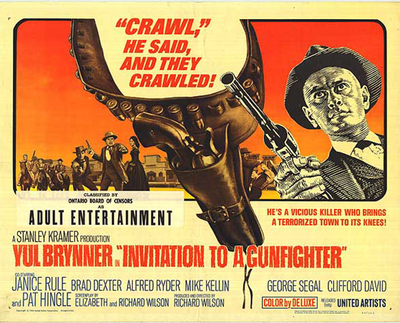When we imagine a western movie, our mind usually evokes images of cowboys, gunmen, stage coaches, cattle drives and wagons traveling over panoramic landscapes like Monument Valley, the dusty canyons in or around Los Angeles where even the poorest b-movie production could find locations, or the arid landscapes of southern Spain where spaghetti westerns filmed. We need to be prodded to remember the western towns where both the white and black hats watered and rested their horses, shot up saloons or faced each other in showdowns on rutted main streets.
These western towns – real places like Deadwood, Tombstone, Dodge City and Santa Fe or fake ones built on studio backlots or outside L.A. city limits – are really the more crucial setting of the American western, as settlement and civilization was the ultimate endgame of the encroaching frontier and manifest destiny. They're the point of the spear of eastern interests moving across the continent, home of the merchant, the banker, the marshal, the court, the land speculator, the railway station, the mining claims office and the cattle agent; the place where the dream of wide open spaces and limitless opportunity meets the reality of capital, government and the law.
The homesteader's cabin, the rancher's hacienda and the cowboy's camp evoke agency and freedom, while the town is the place where work becomes a job, where opportunity is regulated by bureaucrats a thousand miles away, and where the frontiersman becomes a citizen. It's no wonder that many western movie towns are such dire and dismal places. Or as Yul Brynner, speaking as the titular character in Invitation to a Gunfighter (1964), describes the dusty settlement where he walks off the stagecoach into a whole bunch of trouble – "the dirtiest of towns on the dirty face of the earth."
The film begins with a stagecoach driving through a sun-bleached southwestern landscape in the New Mexico Territory. On the stagecoach is a man in fine tailored black clothing who athletically curls out the window of the moving coach onto its roof and then next to the driver in a single, elegant move. Walking alongside the road is a man in a torn and faded Confederate uniform, his gun over his shoulder, barely acknowledged by the driver and his passenger.
The man in the uniform is Weaver (George Segal), a recently mustered-out rebel soldier on his way back to the home he discovers he no longer owns. While away fighting for the lost cause his family homestead was illegally confiscated and auctioned off by Brewster (Pat Hingle), the town's big man and bank owner. Medford, the new owner (Russell Johnson – the Professor from Gilligan's Island, and uncredited in the film) tries to chase Weaver away, and makes the mistake of trying to pull a revolver on the town's only dead shot when he returns later, making his wife a widow.
The town declared for the Union, and in the aftermath of the Civil War Brewster is trying to cover his tracks and stir up the citizenry by painting the roaming army of demobbed rebs – embodied by the lone Weaver – as a menace to be repulsed. The town sheriff is a drunk and its male citizenry either shopkeepers or damaged and crippled veterans, so Brewster sends off Crane Adams (Clifford David), a one-armed former soldier, to the nearest big town to hire a gunfighter to take on Weaver, now holed up in his reclaimed homestead.
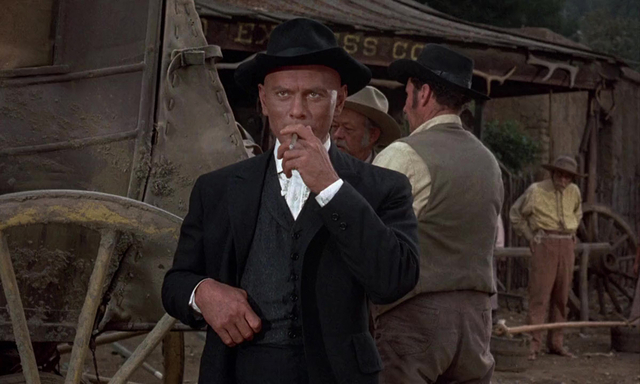
The well-dressed man in black (Brynner) walks off the stagecoach into the middle of the drama and decides to hang around. He signs the hotel register as Jules Gaspard d'Estaing, a Creole from New Orleans, and after a drily humorous scene where he tries to teach Brewster and the townsfolk how to pronounce his name, resigns himself to being called Jewel for the rest of the movie. When Crane returns with a skittish young gunslinger, all Jules has to do is say his name and the young gun bolts, running after the stagecoach and out of the movie.
Jules convinces Brewster that he's the hired gun they need to take care of their Weaver problem, and he decides that since the only place in town to buy ammunition is the emporium, owned by Crane but really run by his wife Ruth (Janice Rule), he moves into their spare room. Like any red-blooded man he can't help but notice Rule, who's as much the bait as the store's stock of bullets and shells, as she was Weaver's fiancée before the war, marrying Crane to punish the man she loved for leaving her to fight for a cause she hated.
Invitation to a Gunfighter began life as a teleplay, written by TV veteran Larry Klein for CBS' Playhouse 90, and adapted by director Richard Wilson and his wife Elizabeth. Wilson is an obscure figure today; he began his career with Orson Welles' Mercury Theater, working on Welles' legendary stage productions like his Julius Caesar, set in fascist Europe, and the War of the Worlds radio broadcast.
During the war he worked for the Office of Strategic Services, and returned to Hollywood as a writer, producer and director, with a filmography that included just one other western, Man with the Gun (1955), a handful of crime and noir pictures and a swinging sex comedy (1968's Three in the Attic). His wife Elizabeth, the daughter of Myrtle Owen, a silent film actress, was called upon by HUAC to testify about her membership in the Communist Party in 1951.
The name that stands out in the credits, however, is that of Stanley Kramer, whose production company helped make Invitation to a Gunfighter. Kramer is famous – then and now – as the man behind a number of famous "message pictures," both as a producer (Home of the Brave, The Men, High Noon, Death of a Salesman, The Caine Mutiny) and a director (The Defiant Ones, On the Beach, Inherit the Wind, Judgment at Nuremberg, Ship of Fools, Guess Who's Coming to Dinner.) A Kramer picture was both important – critics would say self-important – and as subtle as a mallet to the forehead, taking on social issues with varying degrees of bombast or preachiness. Invitation to a Gunfighter fits squarely into the Kramer canon.

The town and the film are entirely free of Native Americans, though when the hotel owner scrutinizes Jules before he signs the register, he suggests that the gunslinger might be more comfortable on "the other side of town," where the Mexican population lives. Brynner was an actor whose career was built on being "exotic" – which is to say racially ambiguous. This refugee from Soviet Russia could play Rameses, Solomon, Taras Bulba, an Indian chief and the King of Siam. In the same year Invitation to a Gunfighter was released he played a Japanese-American in Flight from Ashiya; in the decade that followed he'd play an Israeli (Cast a Giant Shadow), a German baron (Triple Cross), Pancho Villa (Villa Rides) and a robot gunslinger (Westworld).
The Wilsons' script is at pains to point out that the Mexicans, like the town's women, don't have the vote, even though it's women like Ruth whose "women's work" seems to keep the place viable, since so many of the mean have been left blind, crippled or shell-shocked by the recent war. Many of those women are war widows, dependent on the predatory shopkeepers and Brewster for their survival; it's a demoralized place, where a man like Brewster can intimidate his way to the top, though he needs to eliminate the threat of Weaver as soon as he can.
It's hard not to see why setting the picture just after the Civil War gave it the sort of social relevance that Kramer always sought in his movies; the unrest of the civil rights era was simply an ever-resonating echo of the war and its imperfect, unfinished Reconstruction afterward. As a Creole – son of a French father who educated him above his station and a slave mother who that father sold when she caused too much trouble for him – Jules embodies the cause the war was fought for, whose arrival in the flesh causes discomfort and confusion for the townsfolk who supported the Union cause in principle but not in practice.
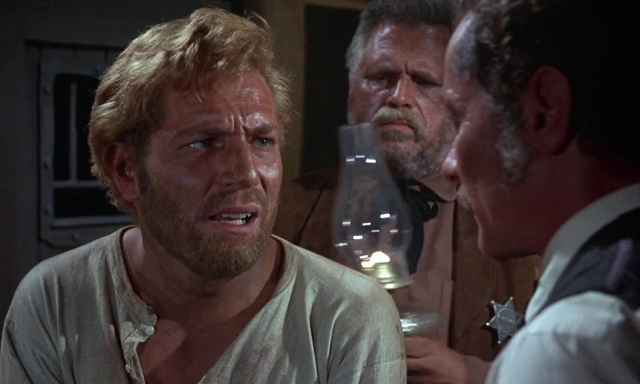
Ironically, Segal's Weaver, the reb, is not only apparently indifferent to Jules' race but a longtime friend to the town's Mexican population – the only one they have, apparently. He tells Ruth that he didn't fight to defend slavery, but to find his father when he went missing during the conflict. Seen through today's lens, it's as if Kramer and the Wilsons wanted to shame hypocritical, virtue-signaling liberals who supported civil rights as long as the battles stayed far away, preferably in some southern town, while quietly maintaining the status quo.
Brynner's Jules is an agent of chaos, with an agenda he doesn't disclose until later in the film. He spends his time fleecing the men at poker, forcing them to cower on the floor when he demonstrates his marksmanship, and makes Brewster carry his luggage across the street from the hotel to the emporium. Jules admits to Ruth that he's playing a very different game to the one Brewster's paid him for:
"A town that hires a gunfighter is always a henhouse with just one rooster. A few fat capons; a few clipped wings. What happens when a man with a gun walks in? That's play, Mrs. Adams – fun. When the fun is over I'll pull the trigger."
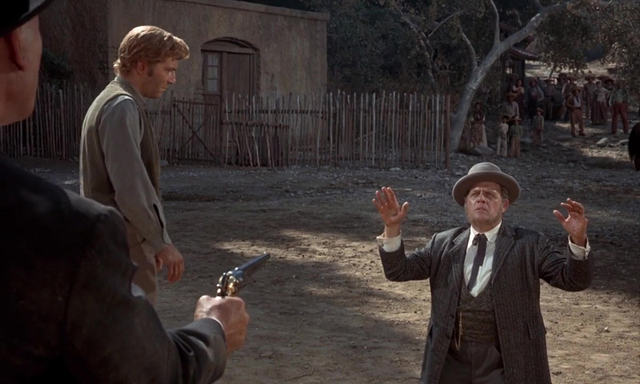
The film begins with the town scared of Weaver, and Jules makes sure they're scared of him as well. Audiences had, of course, seen this frightened town before, in Kramer's High Noon, where Gary Cooper's sheriff goes from hero to outcast when the vengeful outlaws are on their way. But Wilson's film ends up anticipating a much more bleak, damned western town – the one terrorized, saved and then destroyed by Clint Eastwood's nameless, probably supernatural gunslinger in his nihilistic 1973 masterpiece High Plains Drifter.
When he realizes that Ruth might leave her husband but not Weaver, Jules starts spending time on the Mexican side of town, where he gets drunk and returns to the main street to begin a rampage, smashing windows, destroying storefronts and looting goods that he loads on to a donkey cart.
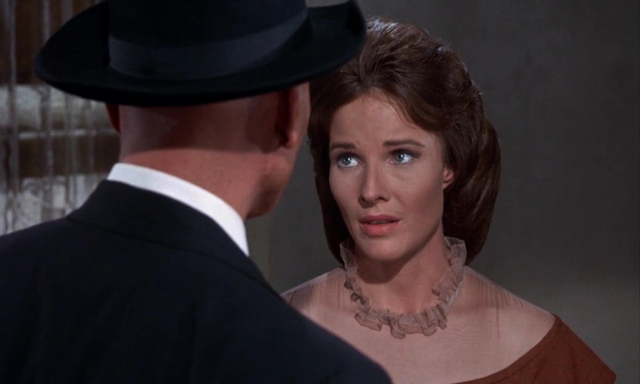
Having established himself as the rooster, he does it in full view of Brewster and the town's men, who don't lift a finger to stop him, even when he commands Brewster to get on his knees and apologize to his mule. The only men who resist are the sheriff – neatly disarmed by a single shot from the gunfighter – and Crane, primed to a jealous rage by both Weaver and Jules. The gunfighter shows him less mercy, and makes Ruth a widow.
In The Western from Silents to the Seventies, George Fenin and William Everson note that the postwar era saw the genre take on a tone more resonant with the liberal politics of the day. The key was Delmer Daves' Broken Arrow (1950), where Jimmy Stewart marries the Indian princess played by Debra Paget, though she doesn't survive to the end of the film – "...for the next few years, Indian brides of white men were doomed to die before the final reel" they write, perhaps as a final spasm of "Production Code jitters."
Early silent westerns had been sympathetic to Native Americans, but in the '50s there were a string of films that sided with Indians cheated by crooked traders or provoked to war by Indian-hating army officers (Two Flags West, Tomahawk, The Last Frontier, Across the Wide Missouri, White Feather, Walk the Proud Land, The Battle at Apache Pass, Sitting Bull, Chief Crazy Horse, The Savage). In Broken Lance, reviewed here recently, racist townspeople tacitly agree to call Spencer Tracy's native wife a Mexican out of wary, misguided respect for the rich and powerful rancher.
While this change in tone was doubtless a reflection of the politics of many stars, writers and directors in Hollywood, it was also a response to the zeitgeist, and the success of anti-racist "message" pictures like Elia Kazan's Pinky; making westerns with a social message was not only socially acceptable in Hollywood, but apparently profitable at the box office. (In any case, Invitation to a Gunfighter lost money on its release.)
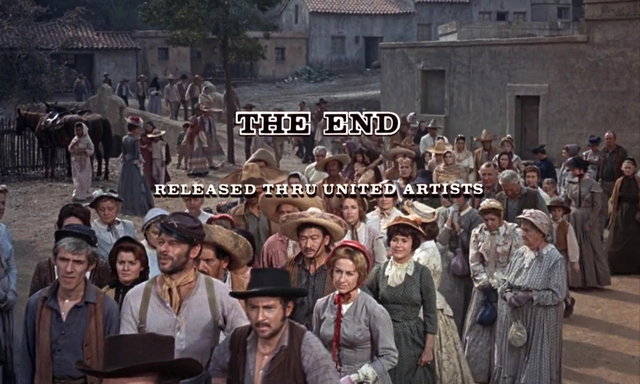
Just as any good western has to end with a shoot-out and, just as crucially, a sacrifice to balance the books and force a moral purge, Invitation to a Gunfighter ends with more than one body lying in the street, and the townspeople – white and Mexican – united to bury their past, literally and metaphorically. It's a high-minded kind of denouement, but it seems cheap and easy compared to the bodies that were actually piling up during the civil rights era. By the time Eastwood made High Plains Drifter, however, the cost was understood to be far steeper, the potential for emerging morally transformed considerably diminished, and the town ultimately beyond saving.
Mark Steyn Club members can let Rick know what they think by logging in and sharing in the comments below, as access to the comments section is one of many benefits that comes along with membership in the Mark Steyn Club.


